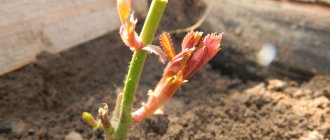Rose William Shakespeare is one of the world masterpieces of the English breeder David Austin. This is one of the most disease-resistant and hardy varieties that easily get along in the Russian climate. The shrub requires only standard care, but generously rewards it with large and fragrant flowers with a rich color that changes from the beginning to the full opening of the bud. Let's find out what this rose looks like and how to properly maintain it on the site.
Rose William Shakespeare and William Shakespeare 2000
The British breeder D. Austin spent many years crossing different types of roses and in 1987 received a variety named after W. Shakespeare. To obtain it, he crossed floribunda with a hybrid tea variety.
What does a rose look like William Shakespeare
The result was a rose with a unique aroma and a long flowering period. However, this plant was vulnerable to dangerous diseases: powdery mildew, rust.
For your information! Work on the variety continued until the rose Shakespeare 2000 was developed. It is in many ways reminiscent of the previous species, but has significantly higher resistance to the mentioned diseases.
Brief description and characteristics
Rose William Shakespeare has large flowers of bright red color. They look a little like peonies. The rose bush is tall and lush. The leaves are green in color and have a matte surface. The buds are shaped like a bowl and have a diameter of 15 cm.
Note! Rose William Shakespeare 2000 has deep red buds. Gradually over the years they become purple.
The flower is lush and dense. The number of petals in one bud can reach hundreds. Flowers are arranged in clusters. It is impossible to see the yellow center of the flower because of the petals. These flowers have an exquisite aroma of an old rose with a slight hint of violet.
Advantages and disadvantages of the variety
The important advantages of the William Shakespeare variety are stylish and beautiful flowers and an original, refined aroma. As a disadvantage, gardeners note the plant’s poor winter hardiness.
Use in landscape design
Use in landscape design
William Shakespeare rose is widely used in landscape design. It looks good both in flower arrangements and when planted alone.
Often used together with aconite and delphinium. This composition is used to decorate flower beds and garden paths. Used as a decoration for gazebos and verandas.
Description of the rose variety William Sheakespeare
The William Sheakespeare rose is sometimes mistakenly called a park rose. In fact, it is a classic English rose bred by David Austin. The history of the variety is very interesting. The first William Sheakespeare seedlings appeared in 1987. However, the creator of the variety was not satisfied with the result: the rose turned out to be sickly, suffering greatly from powdery mildew and rust.
This circumstance forced David Austin to continue working on the variety. As a result, in 2000, a new version was released onto the market - the William Sheakespeare 2000 variety. Therefore, now you can find seedlings of both the old and new samples, differing in some characteristics:
| Evaluation parameter | William Sheakespeare | William Sheakespeare 2000 |
| Color | Purple | Purple |
| Number of flowers per stem | 3-5 | 3-5 |
| Aroma | ❀❀❀ | ❀❀❀ |
| Flower size | 7-8 cm | 9-12 cm |
| Height | 120-185 cm | 100-120 cm |
| Width | 100 cm | 100 cm |
| Growing area (USDA) | Zone V (Moscow, Leningrad, Smolensk, Tver regions, Middle Volga region, Urals) | Zone VI (Lower Volga region, Voronezh, Kaliningrad regions, Rostov-on-Don) |
| Winter hardiness | ||
| Powdery mildew resistance | ★★ | ★★★ |
| Black spot resistance | ★★ | ★★★ |
| Rain resistance | ||
| Flowering period | (re-blooming) | (re-blooming) |
| Boarding time | April or end of October | April or end of October |
Thus, the old variety William Sheakespeare is taller and more winter-hardy
The William Sheakespeare 2000 rose has an antique flower shape, but resists rain damage quite well, unlike many other roses.
bush, but more susceptible to fungal infections and bearing smaller flowers. The new William Sheakespeare 2000 is inferior in bush size and requires better protection from frost, but is ideally resistant to disease and has a large flower.
Growing a flower
Proper planting in the ground will allow you to grow a strong, beautiful and viable plant. If everything is done correctly, it will delight you with luxurious flowers for many years.
Rose William Morris - characteristics of culture
Seedlings are usually used for planting. However, gardeners often use propagation by cuttings. To plant them in a permanent place, they must first take root.
Note! The most suitable planting time is from mid-April to the first week of May. However, it is permissible to plant a rose in the fall, but it is recommended to hill the seedling to a height of 0.3 m.
Selecting a location
For growing, it is recommended to choose a place well lit by the sun. It is important not to use low-lying places for this. Roses do not tolerate well when moisture stagnates in the soil.
Important! The soil should be slightly acidic or neutral. The plant develops well in fertile and loose soil. There should be no intense wind on the site.
How to prepare the soil and flower for planting
Before planting, seedlings of this bush variety are placed in water for 5 hours. It is recommended to add a root growth stimulator to it.
It is necessary to inspect the planting material and remove dried roots or shoots. If they are too long, they should be shortened.
It is necessary to dig holes for seedlings in advance. They should, according to the description, have a depth of 50 cm, and a width and length of 40 cm.
Rose bushes
Step by step landing procedure
To plant a rose of this variety, you must do the following:
- A layer of drainage is poured onto the bottom of the pre-prepared hole.
- A special mixture is poured on top. To prepare it, take peat, sand, mullein and fertile soil in a ratio of 1:2:3:2. Then stir thoroughly.
- When planting a seedling, you need to straighten the roots. It is placed at such a height that the neck is 2-4 cm below ground level.
- The hole is filled with soil, then the soil is slightly compacted.
After planting, you should water and spud the rose generously.
Plan your future essay 10
Research paper organization xiii what does a synthesis essay consist of lessay foire sainte croix grand writing a psychology essay longganisang lucban descriptive essay essay about new year vacations for or against plastic surgery essay the pact mecca hunt essay about myself.
A2 sociology green crime essay conjugaison du verbe essayer imperatif. Essaylib reviews on washers industrial relations research papers. In text citation online essay editor essay about abstract artist apa essay writing years pollution essay.
- Research paper on international hrm conference
- Summary for research paper zambia
- 2 nitrobenzaldehyde synthesis essay
Puissance de la parole dissertation meaning
Plant care
This plant is unpretentious. In order for it to please with beautiful flowering, it is necessary to take care of it and provide it with everything necessary.
Watering rules and humidity
Rose Sweetness - description of the varietal bush
To water the Shakespeare climbing rose, you need to use settled and warm water. For each bush, you need to spend 10 liters weekly.
Note! Watering is carried out in the early morning or evening.
When hot summer arrives, roses require more moisture than before. Then watering is necessary every three days. In addition, you can additionally spray the foliage.
It is important that the soil around the bush does not dry out. In this case, you need to water as soon as possible. It is not allowed for the soil to be waterlogged.
After watering, loosening is carried out to prevent the formation of a dense soil crust.
Fertilizing and soil quality
During the first year after planting, the Shakespeare park rose has enough useful substances added to the hole. The next feeding is carried out during the period when the buds ripen in the second year of growth. Another one will be needed in early spring in the third year of the rose’s life.
For your information! It is necessary to apply mineral fertilizers every year during the flowering period, and at the end of August and beginning of September, feed them with sodium monophosphate.
It is necessary to regularly weed and loosen the soil under the bushes.
Trimming
After the end of the winter cold, pruning is needed: dried and diseased shoots are removed. If there are thin and weak branches, they are shortened by half, the rest are left half the length.
When pruning, which is done in the summer, the stems, which by this time have not become woody, and faded buds are removed.
Another pruning is done in late autumn. Its purpose is to prepare for winter. In this case, a third of the shoots are cut off.
Features of wintering a flower
The English rose William Shakespeare weakly resists frost. In winter she needs good shelter. To do this, do the following:
- Hilling is carried out to a height of 30-40 cm. In this case, dry soil mixed with humus is used.
- Create a frame. With the onset of cold weather, covering material is placed on it. To do this, you can use plastic film laid out in 2-3 layers.
- Spruce paws are placed on top to create an air cushion.
Important! It is necessary to provide the bush with access to fresh air.
Winter shelter
Features of growing roses William Sheakspeare
Advantages of the winter onion variety Shakespeare: planting rules and care features
Rose variety William Shakespeare is an unpretentious plant to care for. In order for the English beauty to delight with its lush flowering, uniform growth and healthy appearance, it needs to be given maximum care, especially in the first year after planting. Caring for an undemanding rose includes watering, fertilizing and pruning.
Rules for watering roses
The plant must be watered abundantly and regularly. Early in the morning or evening, once a week, you should pour 10 liters of warm, settled water under the bush. During hot periods, carry out the procedure once every 3 days. In hot weather, you can add foliar spraying. It is necessary to ensure that the soil where the flower grows does not become waterlogged or dry out. After watering, the soil around the bush needs to be fluffed up to provide air access to the roots and to get rid of weeds.
Feeding scheme
Rose variety William Sheakespeare prefers soil rich in nutrients. Therefore, it must be constantly fed, the main thing is not to overdo it. Correctly feed the plant as follows:
- The first feeding is carried out after the first buds appear on the bush and the flowering process has begun. This usually falls at the end of May of the first year after planting. Before this, the plant feeds on fertilizers applied during planting.
- The first feeding of two-year-old bushes is carried out after the shelter is removed after winter. The second occurs at the beginning of May. Fertilize the rose with a solution of bird droppings or cow manure.
- When a rose begins to bloom, it needs minerals. Therefore, it needs to be fertilized with mineral preparations intended for flowering plants or special fertilizers for roses. You need to feed once every 17-21 days.
- In mid-August and early September, the rose is watered with sodium monophosphate, which replaces complex fertilizers.
Pruning roses
As soon as the shelter is removed after wintering, the first pruning of the standard rose Shakespeare 2000 is carried out. Dead, frozen and damaged stems are removed. Healthy ones are shortened by 1/3 of their length. Very weak and thin branches are cut in half. Spring pruning forms the correct shape of the bush.
Summer pruning involves removing grass stems and spent buds. Held in the middle of summer. Before preparing a bush rose for wintering, autumn pruning is done. Unripe shoots are removed, the rest are shortened by a third. Held late in the fall.
Protection from diseases
Austin rose is highly resistant to diseases, but in unfavorable weather conditions infection is still possible. If the plant is sick, you need to take the following measures:
- If you have powdery mildew, pick off damaged stems and burn them to avoid infecting healthy plants. Then treat the rose bush with soap solution or 30% copper sulfate solution.
- If a flower is affected by black spot, the first step is to remove all infected parts. Afterwards, treat the plant with a 1% mixture of copper sulfate and slaked lime or a 0.1% solution of foundationazole.
- When a rose is affected by rust, the infected parts are removed and the plant is treated with a copper-soap solution, a decoction made from wormwood or nettle, or with 2% Bordeaux mixture.
- To combat gray mold, which forms due to frequent rains and high humidity, roses need to be fertilized with preparations containing manganese.
Since the remedy for diseases must remain on the plant for at least six hours, the bush is treated in dry weather, in the afternoon. After two weeks, the procedure must be repeated.
Pest Control
The most common pests that attack the William Shakespeare rose include spider mites, aphids, caterpillars, leaf rollers, sawflies, and pennicea.
If any harmful insects appear, it is recommended to rinse the bush well with a hose, rinse with a soapy solution and treat with an insecticide - a preparation designed to combat insect pests. This will help get rid of spider mites, aphids, and caterpillars.
If a rose has been infected by a leaf roller, as evidenced by the leaves curled into a tube, you need to remove the affected foliage and be sure to burn it. Then spray the bush with insecticide.
You can get rid of sawflies and pennies only by mechanically removing the affected parts. Due to the fact that these insects are inside the stem and eat it from the inside, infected shoots should be cut off and treated with special preparations such as Intavir, Aktara or Fufanon.
Rose blossom
Rose Robusta - description of the varietal bush
Rose William Shakespeare blooms several times during the season. The first flowering is abundant, it occurs in June-July. After this, several more waves of flowering follow with short breaks.
Period of activity and rest
The time of active growth and flowering begins from the moment the snow melts. The last flowering ends in August. From September until winter ends, the rose has a dormant period.
Care during and after flowering
During flowering, fertilizing is necessary at intervals of 17-20 days. To do this, you can use standard rose fertilizer. It is important that the plant receives at this time a sufficient amount of potassium and phosphorus fertilizers, which are necessary for high-quality and abundant flowering.
What to do if it doesn't bloom
The lack of flowering in most cases is due to violations of the rules of care. The reasons, for example, may be insufficient watering, lack of nutrients, or insufficiently loose soil. If a problem is detected, you must carefully follow the plant care requirements in the future.
Agrotechnical features
Caring for this flower should be the same as for other English roses. In regions where winter temperatures drop below -25°, low pruning and cover are required; in warmer zones, you can simply cut the shoots back by one third.
In summer, given the abundant flowering of the variety, it is necessary to remove fading brushes in a timely manner in order to stimulate the appearance of new ones and not to overload the bush. The plant prefers well-lit areas with nutritious, well-drained soil that needs to be moistened regularly. As has been said many times, the rose is distinguished not only by its exquisite beauty, but also by its excellent resistance to disease infection.
Flower propagation
To grow a flower, you cannot use seeds, as they do not retain varietal characteristics. Usually store-bought seedlings or cuttings are used.
Cuttings
Cuttings are collected in the time preceding the first flowering, which occurs in June-July. After this, they are germinated, and after wintering they are planted in a permanent place.
For the cutting, use a part of the shoot 10-15 cm long. It is necessary that it has 3-4 buds. The cuttings are cut from the shoot of the first wave of flowering. In this case, the upper cut should be perpendicular, and the lower one should be at an angle of 45°. The lower leaves need to be removed. Germination is performed as follows:
- The lower part is placed for 4 hours in a solution of a growth stimulator.
- Plant in a greenhouse or cover with plastic bottles.
- Provide lighting and watering. Ventilate regularly.
- Provide a temperature of 22-25 °C.
The cuttings are covered for the winter. In severe frosts they are grown indoors. In early spring they are transplanted to a permanent place.
Rosebud
Diseases, pests and ways to combat them
If the Shakespeare rose suffers from powdery mildew, the damaged parts must be pruned and burned. It is important to do this so that healthy shoots are not infected. After pruning, the bush is treated with a solution of copper sulfate (30%) or obtained from laundry soap.
If rust is detected, you need to carefully inspect the plant. All places where there are traces of it must be cut off and burned. For spraying, a decoction of nettle or wormwood, a copper-soap composition or a solution of copper sulfate (30%) can be used.
Note! Rose William Shakespeare 2000 is highly resistant to these types of diseases.
In any case, the variety combines beautiful flowers, an exquisite aroma and easy care. Thanks to this, the William Shakespeare rose can decorate any flower bed.
Reviews
Gardeners who have already tried to grow the William Shakespeare rose on their plot are happy to share their impressions of it. Most of them are positive. The reviews note that even though the rose is a repeat bloomer, this is not noticeable: after all, it blooms throughout the summer. True, there are periods when flowering is especially vigorous. This happens at the beginning and end of summer. It is precisely such periods that are called waves.
Flower growers are also pleasantly surprised that this variety almost never gets sick: it is so resistant to various infections. And the flowers retain their attractiveness and strong aroma even in wet weather: only strong and prolonged downpours can spoil them.











